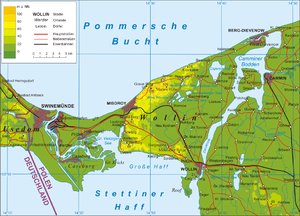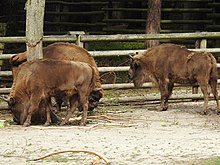Wolin
| Wolin | ||
|---|---|---|
| Wolin Island, West Pomeranian Voivodeship | ||
| Waters | Baltic Sea | |
| Geographical location | 53 ° 55 ' N , 14 ° 34' E | |
|
|
||
| length | 37.5 km | |
| width | 19 km | |
| surface | 265 km² | |
| Highest elevation | Grzywacz 116 m |
|
| Residents | 30,000 113 inhabitants / km² |
|
| main place | Wolin (city) | |
| View from the Swinoujscie lighthouse to the Baltic coast of Wollin | ||
Wolin (German Wollin [ vɔ'li: n ]) is a Baltic Sea - island in the Polish West Pomeranian Voivodeship . It is located in Western Pomerania in front of the Szczecin Lagoon , around 60 km north of Szczecin . It is bordered to the west by the Swine (Polish Świna ) and to the east by the Dziwna (German Dievenow ). It has an area of 265 km² with elevations up to 116 m above sea level (Grzywacz, German Berg Relix). There are seaside resorts on Wolin , u. a. the well-known Baltic Sea resort Międzyzdroje (German Misdroy ). Wolin is by far the largest island in Poland.
geography
The island can be divided into three natural areas. The western peninsula Przytór (German Pritter ), for example from Międzyzdroje to the Swine, consists of geologically very young alluvial land, which was removed by the surf on the coasts of Usedom and Wollin and then formed a large spit in the Swine estuary , on which the subsequent dunes were deposited were. The central part of the island, which also has the largest elevations, is a compression moraine that was formed in the most recent, the Vistula Ice Age . The east of the island is characterized by flat to flat undulating ground moraines . Due to the low altitude above sea level, the lowlands in the eastern part are largely moored .
history
Rich finds of Middle and Neo-Stone Age weapons and devices testify to an early settlement of Wollin. During the Bronze Age , which started here around 1800 BC. Began, the island was in the area of the Nordic Circle . East Germanic tribes settled here later . In 2004 a Germanic grave about 2000 years old was uncovered near the city of Wollin. In the course of the migration, the Germanic peoples left the island. Centuries later, around 700 AD, Slavic turns from the east moved up. As arable farmers, cattle breeders and fishermen, they set up round villages on the rivers and lakes. The most important settlement on the island was the city of Wollin, which had reached the zenith of its development in the Middle Ages. The accumulated riches - even the treasury in the temple of the three-headed Triglav was filled to the brim - generated covetousness among the neighbors.
Around the year 1000 the Vikings repeatedly undertook military campaigns against the island and established trading establishments here, which they built fortresses to protect. The most famous among them was the Jomsburg , which formed the background for the Vineta saga . But not only the Danes and the Swedes, also the Germans tried to subjugate the Wollins. Again and again there were war campaigns of the Poles. In 967, for example, the Polish Duke Mieszko I , who had to pay tribute to Emperor Otto I , attacked Wollin. When Julin (Wollin) was besieged by a Swedish fleet and a Polish army around 1120, the Pomeranian Duke Wartislaw I , who already had the griffin in his coat of arms, had to briefly recognize the supremacy of Poland and also promise the acceptance of Christianity and an annual tribute .
In order to increase his influence on Pomerania , the Polish Duke sent his former teacher, Bishop Otto von Bamberg , to Wollin in 1124 . With the consent of the emperor and the pope, he had accepted the mission of proselytizing the Pomeranian “pagans”. The Christianization that took place in the 12th century was followed by the Germanization of Wollin. In order to consolidate their independence from Poland, the Pomeranian dukes had brought German knights and advisers as well as German and Danish settlers into the country. The Wends were assimilated - mainly through the influence of the Christian Church - and finally also gave up their language.
The time around 1400 - a heyday of German piracy in the Baltic and North Sea - is associated with the pirate Stina on the island. According to tradition, she was also a companion and ally of Klaus Störtebeker . But she operated independently with a small band of buccaneers from Wollin in the Pomeranian Bay. After a large part of the brigands, headed by Störtebeker , had been executed in 1401 on an Elbe island near Hamburg , Stina and her men also went into the net of the henchmen. After that, they were all drowned in Lake Jordan . Even in their case, historical events and their reproduction in legends up to the present day cannot always be clearly separated. However, Stina remains the only known German pirate.
During the Thirty Years' War in 1627 the Imperial General Wallenstein of the Catholic League occupied the island. When the Swedish king Gustav Adolf landed at Peenemünde three years later , the Wallensteins' mercenaries evacuated the battered island of Wollin without resistance. After the Peace of Westphalia in 1648, Wollin was part of Swedish Western Pomerania. In the period that followed, the Great Elector Friedrich Wilhelm von Brandenburg waged several victorious wars against the Swedes. According to the succession agreement, after the death of the Pomeranian Duke Bogislaw XIV, all of Pomerania should have fallen to Brandenburg. However, Louis XIV knew how to prevent this. Finally, in 1713, King Friedrich Wilhelm I of Prussia was granted the islands of Wollin and Usedom through a settlement with the Russian Prince Alexander Danilowitsch Menshikov and with Poland. In the Peace of Stockholm of 1720, Szczecin and the two islands fell to Prussia. Under Friedrich II. There was a sustainable economic development of Wollin for the first time. The forests were used according to plan, schools built, new Büdner sites created, dunes fortified, the Dannenberger Bruch meliorated , the port construction in Swinoujscie accelerated, and much more.
Napoleon's war campaign set the island back decades. The city of Wollin alone had to accommodate and feed 600 French soldiers. The victory over Napoleon in 1813 was followed by a period of relative prosperity in which the island's population nearly doubled. Especially Ostswine, Kalkofen, Pritter and Kolzow as well as the seaside resorts Misdroy, Neuendorf, Heidebrink, West Dievenow, Swantus and Osternothafen contributed to this development.
After the founding of the empire in 1871, Wollin became part of the German Empire. In the final phase of the Second World War, Wollin was captured by the Red Army . The island was then placed under Polish administration. Poles and Ukrainians settled here, most of whom came from the areas east of the Curzon Line that had fallen to the Soviet Union . Unless they had fled the Red Army, the German civilian population was expelled due to the Bierut decrees in the period that followed. Today the island is called Wolin and belongs to Poland.
Places on Wolin


- The districts Warszów ( Ostswine ), Ognica ( Werder ), Przytór ( Pritter ), Łunowo ( Haferhorst ) and Chorzelin ( Osternothhafen ) of the city of Świnoujście ( Swinoujscie )
- Międzyzdroje ( Miedzyzdroje )
- Wolin ( Wollin )
- Międzywodzie ( Heidebrink )
- Wisełka ( Neuendorf on the island of Wollin )
- Kołczewo ( Kolzow )
- Świętoujść ( Swantuss )
- Wapnica ( lime kiln )
- Kodrąb ( Codram )
- Łuskowo ( Lüskow )
- Warnowo ( Warnow )
- Dargobądz ( Dargebanz )
- Lubin ( Lebbin )
- Wicko ( Vietzig )
- Mokrzyca Mała ( Little Mokratz )
- Mokrzyca Wielka ( Large Mokratz )
- Darzowice ( Darsewitz )
- Jarzębowo ( Jarmbow )
traffic
There are ferry connections from Świnoujście (German Swinemünde ) to Ystad ( Sweden ) and Copenhagen . The Swinoujscie ferry terminal is located on the island of Wolin. Road bridges over the Dziwna near the city of Wolin and near Dziwnów (German Dievenow ) and a railway bridge near Wolin lead to the Polish mainland (connection to Stettin ). The most important road connection is state road 3 ( droga krajowa 3 ), which is also a section of European route 65 .
The islands of Usedom and Wolin are connected by ferries that cross the Swine at Świnoujście and Karsibór. The construction of a tunnel was planned as early as 1936 to connect Swinoujscie with the island of Wollin. The project was not implemented because of the outbreak of World War II in 1939, but is now being discussed again because of the increase in road traffic since the border crossings to Germany opened. The planned Swinetunnel would connect Wollin directly to the west.
The island is connected to the Szczecin Dąbie – Świnoujście railway from Szczecin . The connection to the railway Ducherow-Heringsdorf-Wolgast ferry on the Usedom side of Swinoujscie on a ferry to Ostswine was set in 1945 and therefore currently ends at the railway station Świnoujście Centrum .
tourism
Because of its beautiful Baltic Sea beaches (especially in Międzyzdroje, Wisełka and Międzywodzie ) Wollin is a popular holiday destination in summer. Another tourist attraction is the Wollin National Park, founded in 1960 . This currently covers an area of almost 11,000 hectares and has a small wildlife park near Międzyzdroje. There are u. a. to see a herd of the almost extinct bison .
Also interesting are the city of Wolin (city of the Pomeranian reformer Johannes Bugenhagen ) as well as the places Wapnica ( lime kiln ) with its turquoise lake (the former chalk pit of the grandparents of the well-known physician Carl Ludwig Schleich ) and Lubin ( Lebbin ) with its Slavic castle wall .
See also
literature
- Georg Wilhelm von Raumer : The island of Wollin and the seaside resort of Misdroy. A historical sketch. Decker, Berlin 1851 ( online ).
- Heinrich Berghaus : Land book of the Duchy of Pomerania and the Principality of Rügen . Part II, Volume 1, Anklam 1865, pp. 583-592 ( online ).
- Peter August Rolfs (ed.): The island of Wollin. A home book and travel guide. Julius Beltz, Langensalza et al. 1933 ( home book of the Usedom-Wollin district 1), 3rd reprint, Husum-Druck- und Verlags-Gesellschaft, Husum 1993, ISBN 3-88042-245-1 .
- Erwin Rosenthal : The island of Wollin, Kaseburg and Cammin. Rhinoverlag, Ilmenau 2011, ISBN 978-3-939399-09-4 .
- Erwin Rosenthal: Usedom and Wollin. Two sister islands in the Pomeranian Bay . Demmler-Verlag, Ribnitz-Damgarten 2013, ISBN 978-3944102023 .
Web links
- Official information portal Wolin.pl (Polish)
- Woliner National Park (Polish, German, English)
Footnotes
- ^ Lutz Mohr : Stina - a Pomeranian pirate. Just a legendary figure? In: Heimathefte for Mecklenburg and Vorpommern. 18th year, issue 1/2008, pp. 28-29.
- ^ Georg Wilhelm von Raumer: The island of Wollin and the seaside resort of Misdroy: A historical sketch. Berlin 1851.
- ↑ Erwin Rosenthal: The island of Wollin, Kaseburg and Cammin. Rhinoverlag, Ilmenau 2011.
- ↑ Baltic Portal : Ten candidates for tunnel-tender, 27 August 2014





